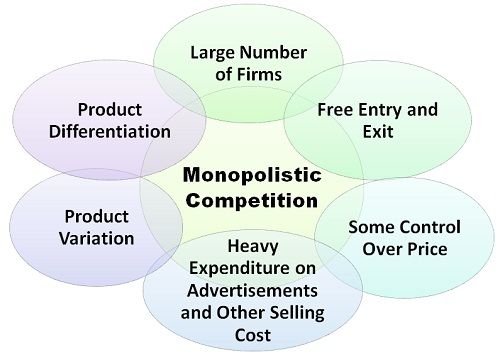Definition: Under, the Monopolistic Competition, there are a large number of firms that produce differentiated products which are close substitutes for each other. In other words, large sellers selling the products that are similar, but not identical and compete with each other on other factors besides price.
Features of Monopolistic Competition
- Product Differentiation: This is one of the major features of the firms operating under the monopolistic competition, that produces the product which is not identical but is slightly different from each other. The products being slightly different from each other remain close substitutes of each other and hence cannot be priced very differently from each other.
- Large number of firms: A large number of firms operate under the monopolistic competition, and there is a stiff competition between the existing firms. Unlike the perfect competition, the firms produce the differentiated products which are substitutes for each other, thus make the competition among the firms a real and a tough one.
- Free Entry and Exit: With an intense competition among the firms, the entity incurring the loss can move out of the industry at any time it wants. Similarly, the new firms can enter into the industry freely, provided it comes up with the unique feature and different variety of products to outstand in the market and meet with the competition already existing in the industry.
- Some control over price: Since, the products are close substitutes for each other, if a firm lowers the price of its product, then the customers of other products will switch over to it. Conversely, with the increase in the price of the product, it will lose its customers to others. Thus, under the monopolistic competition, an individual firm is not a price taker but has some influence over the price of its product.
- Heavy expenditure on Advertisement and other Selling Costs: Under the monopolistic competition, the firms incur a huge cost on advertisements and other selling costs to promote the sale of their products. Since the products are different and are close substitutes for each other; the firms need to undertake the promotional activities to capture a larger market share.
- Product Variation: Under the monopolistic competition, there is a variation in the products offered by several firms. To meet the needs of the customers, each firm tries to adjust its product accordingly. The changes could be in the form of new design, better quality, new packages or container, better materials, etc. Thus, the amount of product a firm is selling in the market depends on the uniqueness of its product and the extent to which it differs from the other products.
The monopolistic competition is also called as imperfect competition because this market structure lies between the pure monopoly and the pure competition.


sanjeev kumar says
Very nice
Shah abuzar says
Nice information
MADZVOVA says
Thank you. Now l got the idea.
Ash says
Thank you for providing us such a wonderful knowledge.
Mratunjay singh parmar says
Good and simple language, and easy to understand
Gurwinder Kaur says
It’s really helpful but Could you post more related posts?
sikapa says
A very good and simple understanding book. God bless you.
mandisa says
Please advise when was this information written and the author. I need it for my referencing purpose
Surbhi S says
The content was written on December 8, 2015 by Megha M.
Itz beautinz says
Wow, this is perfect